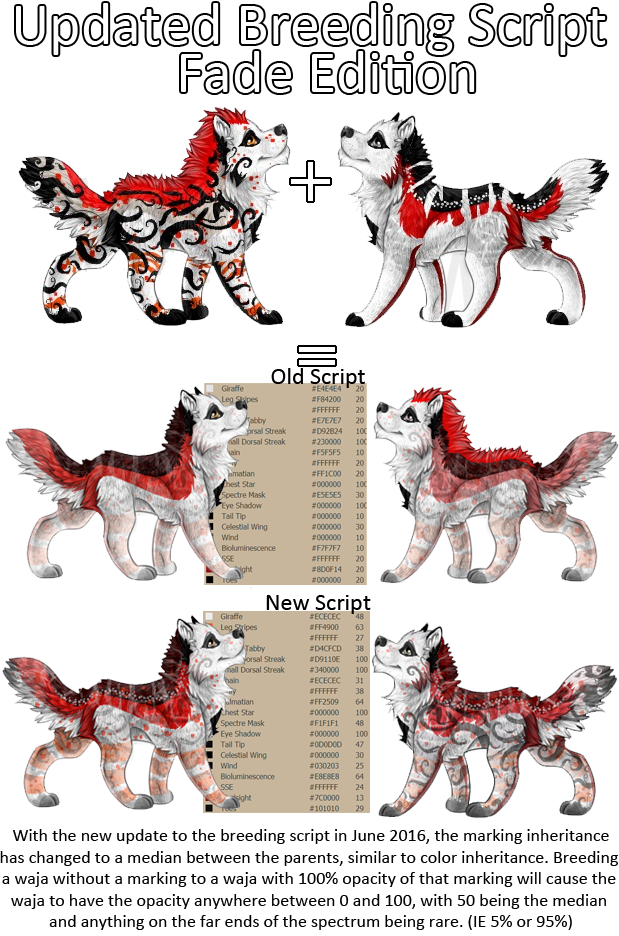Difference between revisions of "Breeding Guide"
Schwarzwald (talk | contribs) m (→Releasing) |
m (→Mutation Inheritance) |
||
| (10 intermediate revisions by 5 users not shown) | |||
| Line 1: | Line 1: | ||
| − | The basics of breeding are very simple. In order to breed you must have two adult wajas (20+ days old) of opposite gender (one male, one female) and either a [[Love Pear]] or [[Ancient Love Pear]], which will be consumed at the time of breeding. If the wajas you want to breed are the same gender, you can feed one a [[Gender Pear]] to instantly change its gender. | + | The basics of breeding are very simple. In order to breed you must have two adult wajas (20+ days old) of opposite [[Gender|gender]] (one male, one female) and either a [[Love Pear]] or [[Ancient Love Pear]], which will be consumed at the time of breeding. If the wajas you want to breed are the same gender, you can feed one a [[Gender Pear]] to instantly change its gender. |
However, to breed nice looking, high quality wajas requires more thought. A lot of this will come with practice, and you will most likely make some mistakes while learning, but this guide is here to help you gain an understanding of breeding that should help you on your way to becoming an excellent breeder! | However, to breed nice looking, high quality wajas requires more thought. A lot of this will come with practice, and you will most likely make some mistakes while learning, but this guide is here to help you gain an understanding of breeding that should help you on your way to becoming an excellent breeder! | ||
| Line 54: | Line 54: | ||
=Love Pear or Ancient Love Pear?= | =Love Pear or Ancient Love Pear?= | ||
| − | + | You may be wondering what the difference between a [[Love Pear]] and an [[Ancient Love Pear]] is. Both can be purchased from the [[Pear Shop]] or from user shops, and both enable wajas to breed, but the appearance of the resulting pups will be vastly different depending on which pear you used because the pears each breed the wajas using a different breeding script. A breeding script is what the site uses to determine how the pups' colors will be generated during a breeding. There are two breeding scripts on wajas, and which one the site uses is determined by which love pear the user selected at the time of breeding. Ancient Love Pear (ALP) breedings use the "old" script. Love Pear (LP) breedings use the "new" script. | |
| − | + | ==Ancient Love Pears - The "Old" Script== | |
| − | <br> | + | Using an [[Ancient Love Pear]] to breed will generate pups using the "old" script. This is the script that the site originally used and which always creates pups of the median color between the two parents' colors. So a red waja crossed with a blue waja will always make roughly the same color purple pup with an Ancient Love Pear breeding. The old script makes predicting how your pup will look very easy, but it also results in pups who all look more or less the same. |
| − | [[File:ALPBreedingsGuide.png]] | + | |
| − | [[File:LPBreedingsGuide.png]] | + | This image further illustrates: |
| + | <br>[[File:ALPBreedingsGuide.png]] | ||
| + | |||
| + | ==Love Pears - The "New" Script== | ||
| + | Using a [[Love Pear]] (sometimes called Regular Love Pear) to breed will generate pups using the "new" script. This script was added somewhat recently and creates pups whose colors can be anywhere on the spectrum between the two parents' colors. So a red waja crossed with a blue waja can make a purple pup, or a blue pup, or a red pup, or anywhere in between. The new script makes predicting how your pup will look difficult, but it also results in far more unique looking pups. | ||
| + | |||
| + | It is important to note that the base color, eye color, and the color of each marking and mutation are all determined independently of each other in any breeding. This means that it is generally unwise to use a regular Love Pear when breeding wajas who have markings that need to match each other to look right. | ||
| + | |||
| + | This image further illustrates: | ||
| + | <br>[[File:LPBreedingsGuide.png]] | ||
=Markings and Mutations= | =Markings and Mutations= | ||
| Line 68: | Line 77: | ||
==Marking Inheritance== | ==Marking Inheritance== | ||
| + | |||
| + | === New Breeding Script === | ||
| + | June of 2016 [[Estuko]] and [[RocketDave]] grouped together to tweak the breeding script for marking inheritance. Estuko explained in the news post that it works like so: | ||
| + | |||
| + | "We changed it around so that the opacity levels are a bit easier to work with. Now you're going to get a middle range most of the time with the slight chance of it being really high or really low. The results should never go above/lower what the parents have though. | ||
| + | |||
| + | *If you breed a waja with '''100 dalmatian''' to another that has '''100 dalmatian''' all the puppies should have '''100 dalmatian.''' | ||
| + | |||
| + | *If you breed a waja with '''100 dalmatian''' to a waja that '''does not have dalmatian''' the range will be '''0-100 but the average will be 30-50s.''' | ||
| + | |||
| + | *If you breed a waja with '''50 dalmatian''' to one with '''40 dalmatian''' the results should never be higher or lower than the parents. So you're looking at '''40-50 opacity.''' | ||
| + | |||
| + | To increase the opacity of the offspring you would then cross them out with someone who has a higher opacity. If you're trying to breed out a marking you would breed it to one that has a lower opacity or doesn't have it at all." | ||
| + | |||
| + | Color range has not been effected by the new breeding script. [[Love Pear]]s and [[Ancient Love Pear]]s still function as normal by either using the median for the colors in the case of the ancient love pear, or using the whole range between the colors with a regular love pear. The following graphic below shows the difference between pups from the old breeding script to the new both examples using [[Love Pear]]s. | ||
| + | |||
| + | [[File:NewScriptBreedingInheritance.png]] | ||
| + | |||
| + | === Older Breeding Script === | ||
When two wajas are bred together, the markings they share will be passed on to their pup at a strength that is between the strength of the marking in the two parents. Markings that are not shared between the two will be passed on at a low opacity, such as 20 or 30, or more rarely it won't be passed on at all. Marking strength in the pup will never be inherited at a higher opacity than its parents possessed, so there is no way to breed two wajas with a marking at 50 and get a pup whose marking is higher than 50. | When two wajas are bred together, the markings they share will be passed on to their pup at a strength that is between the strength of the marking in the two parents. Markings that are not shared between the two will be passed on at a low opacity, such as 20 or 30, or more rarely it won't be passed on at all. Marking strength in the pup will never be inherited at a higher opacity than its parents possessed, so there is no way to breed two wajas with a marking at 50 and get a pup whose marking is higher than 50. | ||
| Line 78: | Line 106: | ||
[[File:FadedMarkingsBreedingGuide.png]] | [[File:FadedMarkingsBreedingGuide.png]] | ||
<br> | <br> | ||
| − | |||
==Mutation Inheritance== | ==Mutation Inheritance== | ||
| Line 87: | Line 114: | ||
SHOW x CARRY: 50% of pups SHOW, 50% CARRY | SHOW x CARRY: 50% of pups SHOW, 50% CARRY | ||
| − | SHOW x NO: | + | SHOW x NO: 50% CARRY, 50% NO |
CARRY x CARRY: 50% CARRY, 25% SHOW, 25% NO | CARRY x CARRY: 50% CARRY, 25% SHOW, 25% NO | ||
| Line 96: | Line 123: | ||
Show means the waja has the mutation and it is visible. Carry means the mutation is not visible in the waja, but there is still a small chance of the mutation being passed to the waja's pups. No means that waja neither shows nor carries the mutation. | Show means the waja has the mutation and it is visible. Carry means the mutation is not visible in the waja, but there is still a small chance of the mutation being passed to the waja's pups. No means that waja neither shows nor carries the mutation. | ||
| − | [[Mutation Gene]], or MU percentage also affects how mutations are inherited. The exact formula isn't well understood, | + | [[Mutation Gene]], or MU percentage also affects how mutations are inherited. The exact formula isn't well understood, and it is frequently debated about whether it actually works in a predictable way at all. It is thought that higher MU results in higher chances of a mutation in the parent showing or carrying in pups. It is also widely believed that you must raise the MU of both parents (even if the other parent doesn't show or carry any mutations) in order to get the best chance of getting pups to show the mutation. Below is an '''approximate''' figure of MU as it effects a pair in which one parent has mutations visible and the other has none at all. |
| + | |||
| + | Show x None w/0MU = ~15% chance of visible mutation | ||
| + | |||
| + | Show x None w/100MU = ~50% chance of visible mutation | ||
| + | |||
| + | ==Mutated Markings and Mutations== | ||
| + | On higher generation pups (pups born generation 4 or higher), MU increases the likelihood of a mutated [[Markings#Mutated Breeding Markings|Marking]] or [[Mutations#Mutated Breeding Mutations|Mutations]] appearing during breeding though the occurrence is rare. Random Mutations and Markings will not appear on a waja between generation 1 through 3. | ||
=Colors= | =Colors= | ||
| − | Most colors on wajas behave the same as they would in mixing paint (Red x Blue = Purple, Red x Yellow = Orange, etc.). However, because we are dealing with light rather than pigment, mixing yellow and blue does not make green. Instead, this combination makes gray. For a more in-depth explanation of how hex codes work, please | + | Most colors on wajas behave the same as they would in mixing paint (Red x Blue = Purple, Red x Yellow = Orange, etc.). However, because we are dealing with light rather than pigment, mixing yellow and blue does not make green. Instead, this combination makes gray. For a more in-depth explanation of how hex codes work, please review the below section about color mixing. |
Color is a very important part of how a waja looks, so it's not enough to just ensure that you're breeding for strong markings; you need to also pay close attention to how two wajas' colors will blend. A very useful tool in doing this is the [[Hex Codes#Color Mixer|Color Mixer]] found under help on the site. Never assume that just because two wajas are pretty they will make pretty babies. Make sure to take into account not only how the base colors will mix, but also how each individual marking's colors will mix. | Color is a very important part of how a waja looks, so it's not enough to just ensure that you're breeding for strong markings; you need to also pay close attention to how two wajas' colors will blend. A very useful tool in doing this is the [[Hex Codes#Color Mixer|Color Mixer]] found under help on the site. Never assume that just because two wajas are pretty they will make pretty babies. Make sure to take into account not only how the base colors will mix, but also how each individual marking's colors will mix. | ||
| Line 107: | Line 141: | ||
Mutations work much the same way. A mutation shared between the two wajas (whether in show or carry form) will show up in a color somewhere on the spectrum between the parents' colors. A mutation not shared in any way will show up in roughly the same color as it is in the parent who has it (if it shows up at all; see the mutations section). | Mutations work much the same way. A mutation shared between the two wajas (whether in show or carry form) will show up in a color somewhere on the spectrum between the parents' colors. A mutation not shared in any way will show up in roughly the same color as it is in the parent who has it (if it shows up at all; see the mutations section). | ||
| − | ====RAINBOW and CHROME Hexes: A special case | + | ==Non Vitamin Color Mixing: The Science== |
| + | ''This article was originally written by Zita(#63153) [[https://www.wajas.com/communicate_topic.php?id=635399 in a sticky]] and with permission is being transposed onto the wiki'' | ||
| + | |||
| + | There are some quirks to the waja color mixing system that aren't immediately obvious when you're new and haven't fooled around with hex codes before. There are 8 colors you can't make by mixing other colors together (primary colors!) and understanding them will help you make good decisions when breeding and picking colors for dyes/customs that you want to be interbreedable. | ||
| + | (Because you can't make these by breeding, but you can breed almost anything from the right combination of the basic 8.) | ||
| + | |||
| + | I'm also gonna tell you why blue and yellow don't make green on Wajas. | ||
| + | |||
| + | ===How Hex Codes Work=== | ||
| + | The [[https://www.wajas.com/help_hex_blender.php color mixer]] page explains a lot of this, but I'll go over it again to refresh you. | ||
| + | |||
| + | Wajas colors are 6 digit hexadecimal codes (hex codes), which are the standard means of describing colors on a computer monitor. The hex code is 3 pairs of digits, describing (in order) how red, green, and blue the color is. | ||
| + | |||
| + | Therefore, a hex code of #123456 is 12 red, 34 green, and 56 blue. | ||
| + | |||
| + | (The letters come in because it's HEXAdecimal, not your regular old 0-9 decimal system you know and love. The letters A-F represent numbers 10-16. I'm sure you can google that if you want to know more about it, it's neat.) | ||
| + | |||
| + | The smallest any of your color values can be is 00 (black, 0 of that color), and the biggest is FF (FF stands for the number 255). 00 and FF are pure. It's impossible to get a 00 or FF when at least one of your waja's parents doesn't already have it. Your pup's numbers for red, green, and blue on each part of their body/each marking will always be somewhere between the parents'. (And maybe the same as the parents', if you're using a regular Love Pear instead of an Ancient Love Pear.) You can't make colors outside your parent range. | ||
| + | |||
| + | There are 8 possible arrangements of "perfect" 00s and FFs in hex color codes, and these 8 unmixable colors are the Primary Colors of wajadom. | ||
| + | |||
| + | ===The Eight Colors You Cannot Mix on Wajas=== | ||
| + | ====Black and White==== | ||
| + | [[File:HexCode000000.png]][[File:HexCodeFFFFFF.png]]<br> | ||
| + | Simple and obvious, right? You can't make #000000 or #FFFFFF, which is why lineages of markless pure white and pure black wajas have always been valuable. | ||
| + | |||
| + | ====The RGB Primaries==== | ||
| + | [[File:HexCodeFF0000.png]][[File:HexCode00FF00.png]][[File:HexCode0000FF.png]]<br> | ||
| + | These pure colors are Red, Green, and Blue. They are each pure in one part of their hex code, while the other two parts are black. | ||
| + | |||
| + | ====The CMY Primaries==== | ||
| + | [[File:HexCode00FFFF.png]][[File:HexCodeFF00FF.png]][[File:HexCodeFFFF00.png]]<br> | ||
| + | These will be familiar if you've read anything about printing ink colors. (You can google CMYK if you're curious.) | ||
| + | Cyan, Magenta, and Yellow are each pure color in two parts of their hex code, with one part left black. | ||
| + | |||
| + | ====What Happens When Combining Primaries==== | ||
| + | (Black and White are pretty obvious, so we'll just talk about the RGBs and CMYs.) | ||
| + | Mixing primaries in the same groups creates colors kind of like the other group. | ||
| + | When you mix any two of Red, Green, and Blue together, you get a dark yellow, a teal, and a purple.<br> | ||
| + | [[File:HexCode7F7F00.png]][[File:HexCode007F7F.png]][[File:HexCode7F007F.png]]<br> | ||
| + | Mixes between the RGB primaries are sort of dark, because each RGB primary has one section at full color and two that are all black in its code. | ||
| + | |||
| + | Like a mirror version of what we just did, mixing Cyan, Magenta, and Yellow produces pastel versions of the RGB primaries.<br> | ||
| + | [[File:HexCode7F7FFF.png]][[File:HexCodeFF7F7F.png]][[File:HexCode7FFF7F.png]]<br> | ||
| + | CMY mixes are lighter, because again: they are two parts color and one part black. | ||
| + | |||
| + | ===Let's Talk About Grey=== | ||
| + | [[File:HexCode7F7F7F.png]]<br> | ||
| + | Grey is the easiest color to mix. Anything where your RGB values are sort of close (or like here, the exact same) will be a shade of grey. All muddy wajas lean toward grey in the end. It is like the color singularity, the point to which all bad color decisions eventually lead if you keep breeding poorly matched wajas. | ||
| + | |||
| + | The mostly-similar numbers also mean, however, that grey is the easiest color to color-correct from. (Like say, if you're trying to breed Roosters and something's not quite right. Once you've bred to grey, the non-grey parent's color will have a very strong influence on the pup.) | ||
| + | |||
| + | ====Why Blue and Yellow Don't Make Green==== | ||
| + | This is one of the most legendary quirks of the hex color mixing system, it trips up newbie waja breeders all the time. Now that you can see these hex codes, this might make some sense.<br> | ||
| + | [[File:HexCode0000FF.png]][[File:HexCodeFFFF00.png]]<br> | ||
| + | |||
| + | The hex for pure blue is #0000FF, it's an RGB primary. | ||
| + | The hex for yellow is #FFFF00, it's a CMY primary. | ||
| + | |||
| + | The FF's and 00's in these codes are exact opposites! | ||
| + | |||
| + | That means, just like pure white and pure black, crossing these two colors will create true grey. (You know. With some wiggle room for the breeding script to go one way or the other.)<br> | ||
| + | [[File:HexCode7F7F7F.png]]<br> | ||
| + | Oops! | ||
| + | |||
| + | (The same thing will happen if you cross Red and Cyan, or Green and Magenta.) | ||
| + | |||
| + | ====The Closest You Can Get: An Example==== | ||
| + | As shown above, mixing your primaries can get you kind of close to each other in a pinch. | ||
| + | |||
| + | Here's a breakdown of how you get a pastel green from other primaries! | ||
| + | |||
| + | You will never get the bright, rich, acid green of #00FF00 without a pure parent, but you can have some success with Yellow and Cyan, not blue. Cyan is a CMY primary, and you can use the red value in yellow to filter the blue out of cyan. Look here.<br> | ||
| + | [[File:HexCodeFFFF00.png]][[File:HexCode00FFFF.png]]<br> | ||
| + | Check the lineups: | ||
| + | The hex for yellow is #FFFF00 | ||
| + | The hex for cyan is #00FFFF | ||
| + | |||
| + | They both have an FF in green. One has nothing in blue, while the other has nothing in red. When bred, the pup will have a middle value in red and blue. Because those two values are the same (or close), they cancel each other out and the green shines through. Your result is going to be somewhat greyed because you have something besides 00 in your red and blue, but it works!<br> | ||
| + | [[File:HexCode7FFF7F.png]]<br> | ||
| + | (The same holds true if you want to breed a red from Yellow/Magenta or a blue from Cyan/Magenta.) | ||
| + | |||
| + | You'll get better results if the colors you're mixing are closer to the one you want. Knowing this, you can select mates to manipulate colors without having to check the color mixer so much. | ||
| + | |||
| + | If you want to breed a primary color waja, it's best to find wajas that are already pure in that color (or close enough, if you don't need pure). But if you just want to get something sorta close (maybe so you can breed it with a more ideal mate), you now know enough to help yourself do so! :D | ||
| + | |||
| + | |||
| + | ==RAINBOW and CHROME Hexes: A special case== | ||
If a waja with a marking with "RAINBOW" in the hex code field is bred to another waja with the marking in a regular hex color, the pups will always inherit the marking in rainbow if an Ancient Love Pear was used. However, if a regular Love Pear was used, there is a very small chance that the pup might inherit the exact hex of the non-rainbow parent. | If a waja with a marking with "RAINBOW" in the hex code field is bred to another waja with the marking in a regular hex color, the pups will always inherit the marking in rainbow if an Ancient Love Pear was used. However, if a regular Love Pear was used, there is a very small chance that the pup might inherit the exact hex of the non-rainbow parent. | ||
| Line 149: | Line 270: | ||
|} | |} | ||
| − | LQ can be viewed on the waja's page. You can raise a waja's LQ by feeding it [[Normal Pears]]. | + | LQ can be viewed on the waja's page. You can raise a waja's LQ by feeding it [[Normal Pear|Normal Pears]]. |
==Mutation Gene== | ==Mutation Gene== | ||
''Main article: [[Mutation Gene]]'' | ''Main article: [[Mutation Gene]]'' | ||
| − | [[MU]] = Mutation Gene. Mutation Gene, more commonly known as MU, is a stat that determines the likelihood of the waja's pups inheriting the [[mutations]] of the parents. | + | [[MU]] = Mutation Gene. Mutation Gene, more commonly known as MU, is a stat that determines the likelihood of the waja's pups inheriting the [[mutations]] of the parents. On higher generation pups (pups born generation 4 or higher), this stat increases the likelihood of a mutated [[Marking]] or [[Mutation]] appearing though the occurrence is rare. |
MU can be viewed on the waja's page. You can raise a waja's MU by feeding it [[Strange Pears]]. | MU can be viewed on the waja's page. You can raise a waja's MU by feeding it [[Strange Pears]]. | ||
| Line 181: | Line 302: | ||
#Now we can start filling in opacities. For any marking that they share, pick roughly the average of their opacities and enter it (keeping in mind that markings are inherited in increments of 10). So if the mother had a marking at 100 and the father had the marking at 50, we're going to guess about 70. | #Now we can start filling in opacities. For any marking that they share, pick roughly the average of their opacities and enter it (keeping in mind that markings are inherited in increments of 10). So if the mother had a marking at 100 and the father had the marking at 50, we're going to guess about 70. | ||
#For any marking they don't share, set the opacity at 10 or 20. Remember that a marking cannot be inherited by a pup at a higher opacity than the parents had. So if one parent has a marking at 10 and the other parent doesn't have it at all, you can guess that marking's opacity as being 10, but not 20. | #For any marking they don't share, set the opacity at 10 or 20. Remember that a marking cannot be inherited by a pup at a higher opacity than the parents had. So if one parent has a marking at 10 and the other parent doesn't have it at all, you can guess that marking's opacity as being 10, but not 20. | ||
| − | #Now, for base color, eye color, and each marking they share, enter their colors into the [[Hex Codes#Color Mixer|Color Mixer]]. Copy and paste the median color's code into the corresponding slot in the Custom Demo. | + | #Now, for base color, eye color, misc color, and each marking they share, enter their colors into the [[Hex Codes#Color Mixer|Color Mixer]]. Copy and paste the median color's code into the corresponding slot in the Custom Demo. |
#If they both share a mutation, or if they both carry the mutation and you'd like to see how it might look if it shows up in the pups, do the same for the mutation. | #If they both share a mutation, or if they both carry the mutation and you'd like to see how it might look if it shows up in the pups, do the same for the mutation. | ||
#If one waja shows/carries a mutation but the other does not, then if it shows up it will show up in the color of the parent who has it, just like unshared markings do. However, it is unlikely it will show up unless the wajas have a high [[MU]] | #If one waja shows/carries a mutation but the other does not, then if it shows up it will show up in the color of the parent who has it, just like unshared markings do. However, it is unlikely it will show up unless the wajas have a high [[MU]] | ||
Latest revision as of 14:03, 26 May 2022
The basics of breeding are very simple. In order to breed you must have two adult wajas (20+ days old) of opposite gender (one male, one female) and either a Love Pear or Ancient Love Pear, which will be consumed at the time of breeding. If the wajas you want to breed are the same gender, you can feed one a Gender Pear to instantly change its gender.
However, to breed nice looking, high quality wajas requires more thought. A lot of this will come with practice, and you will most likely make some mistakes while learning, but this guide is here to help you gain an understanding of breeding that should help you on your way to becoming an excellent breeder!
Contents
- 1 How to Breed: Step-by-Step
- 2 Pup Stages
- 3 Love Pear or Ancient Love Pear?
- 4 Markings and Mutations
- 5 Colors
- 6 Breeding Stats
- 7 Pup Predicting
- 8 Breeding for Profit
- 9 Releasing
- 10 Common Terms Used in Breeding
How to Breed: Step-by-Step
This section will tell you the extreme, bare-bones basics of how to breed two wajas together. Later sections will go more in-depth into how to breed quality wajas, so it is highly recommended that you read them as well.
In-Cave Breedings
In-Cave breeding refers to breedings that take place between two wajas that you own.
- First, you're going to need to own two wajas of opposite gender who are both adults (20 days old or older).
- Next, you're going to need to make sure you own a Love Pear or Ancient Love Pear. To determine which pear you should use, please see the Love Pear or Ancient Love Pear? section below.
- Go to your cave. Locate and click on one of the two wajas you wish to breed. On its page, underneath the "Equipped Items" section, you should see a large button that says "Breed?". Click it.
- Because this is an in-cave breeding, we are going to skip over the comments section. Under "Deliver Pups To" make sure the pups are set to be sent to whoever you want them to be sent to. Setting this to "Mother" will have them sent to the owner of the mother. "Father" will send them to the owner of the father. "Player" will send them to the player whose ID number you put in the box marked "User ID". It is VERY important that you make sure this is correct, because you can't change it later and if the pups end up sent to someone else then you may not be able to get them back.
- Under the Love Pear section, select whichever kind of love pear you want to use for this breeding. If you're unsure of which love pear you should use, please see the Love Pear or Ancient Love Pear? section below. You must have at least one of the love pear selected in your inventory for the breeding to be successful.
- Scroll down and you will see a list of all of your wajas of the opposite gender to the one you're trying to breed. They will be organised in the groups of your cave, so make sure to select the correct group from the drop down box. Select the waja that you're wanting to breed with. Check, check, and double check that it is the correct waja, as you cannot cancel a pregnancy once it's started.
- Once you're sure you have it right, click Submit. You will be notified that the female is now pregnant.
- Your waja will give birth in 5 days at around the time she was bred. Her page will list her due date and the approximate time, as well as who the father of her pups are. It will also tell you who the pups are set to be delivered to.
Out of Cave Breedings
Out of Cave Breeding refers to breeding a waja of yours with a waja owned by someone else
- If the waja of yours that you want to breed is female, you're going to need to find a male waja that is up for stud. If your waja is male, you're going to have to find a female waja that is up for Reverse Breeding (RB).
- To find a waja that is up for Stud/RB, you can either browse the Stud/Reverse Breeding board on the forums or by using the Waja Search found under World.
- If you're new to the waja search, you can vist the Waja Search page for an explanation on how to use it.
- Using one of these two methods, find a waja that is opposite gender to yours and has the gender, markings, mutations, and colors that you want. Go to that waja's page.
- Check that the waja's owner is active. You can do this by going to their profile page and checking when their last login date was. It would be a shame to go to all the trouble of sending a breeding request to a user who hasn't logged in for over a year.
- This part is very, very important. Before you even think of clicking the breed button, READ THAT USER'S CAVE RULES. They should be listed under the waja's description in the section marked "Cave Rules". Here you should find the user's policies on things like how multiple pup births will be divided between you and whether or not they require you to send a love pear when breeding with their females (note:If a love pear rule isn't mentioned, it's still considered common courtesy to send them a love pear if it's their female. Failing to do so may result in them denying your breed request). For more information on cave rules, please see Cave Rules.
- If you find that you agree to the user's cave rules and have enough WC on hand for the breed fee, you may now click the "Breed" button.
- You will be taken to a new page with information you'll need to fill out.
- First you'll likely see a section for you to write a message to the owner of the waja you're wanting to breed with. This will be sent to them along with your request. It isn't necessary to send any message at all, but you can if you wish.
- Under "Deliver Pups To" make sure the pups are set to be sent to whoever you want them to be sent to. Setting this to "Mother" will have them sent to the owner of the mother. "Father" will send them to the owner of the father. "Player" will send them to the player whose ID number you put in the box marked "User ID". It is VERY important that you make sure this is correct, because you can't change it later and if the pups end up sent to someone else then you may not be able to get them back.
- Under the Love Pear section, select whichever kind of love pear you want to use for this breeding. If you're unsure of which love pear you should use, please see the Love Pear or Ancient Love Pear? section below. The owner of the female must have at least one of the love pear selected in their inventory for the breeding to be successful.
- Scroll down and you will see a list of all of your wajas of the opposite gender to the one you're trying to breed with. They will be organised in the groups of the owners' cave, so make sure to select the correct group from the drop down box. Select the waja that you're wanting to breed with. Check, check, and double check that it is the correct waja, as you cannot cancel a pregnancy once it's started.
- Once you're satisfied that everything is correct, you may now click submit.
- A breeding request will be sent to the owner of the other waja. They will now be able to either accept or decline the breed request.
- You can check on both incoming and outgoing breed requests by going to the "Breed Requests" page under "Home". Here you can cancel your breed request if you change your mind and it hasn't yet been accepted.
- If the breed request is accepted, the female will become pregnant and will give birth in 5 days at around the time she was bred. Her page will list her due date and the approximate time, as well as who the father of her pups are. It will also tell you who the pups are set to be delivered to.
Pup Stages
Main Article: Life Cycle of a Waja
Once born, wajas will display their "Pup" image. All pups of the same breed will have the same appearance and be the same solid color from birth until they are 5 days old. At this stage you cannot see the waja's true base color, eye color, markings, or mutations on their image. Items put on waja pups will not show up. Obviously, wajas in this life stage cannot breed.
At 5 days old, the pups will become Adolescents. When their picture is refreshed, they will now display their "Teen" image, which will show their true coat color, but not their true eye color, markings, or mutations. Though it does not show up in the picture, their eye color is displayed as part of their information under "eye color". Items put on adolescent wajas will not show up. Wajas will remain in the adolescent stage of life until they are 12 days old. Adolescent wajas cannot be bred.
When a waja reaches the age of 12 days, it becomes a "Young Adult". When their picture is refreshed, it will show their "adult" image which features their true base and eye color as well as all markings and mutations. This is the image they will have for the rest of their life. Items can now be placed on the waja and show up correctly. Wajas stay in this life stage until they are 20 days old. Young Adult wajas cannot be bred.
At 20 days old the waja is finally an Adult. Its image will not be different, but it is now finally old enough to breed. If you're impatient, you can feed an Age Pear to a pup to make it instantly reach this life stage. Adulthood is the final life stage of a waja; no matter how much older it gets it will not show signs of aging, nor will it ever die.
Remember! In order for your waja to change appearance, you must click on its picture to refresh it and then refresh the page to see the changes. If the image does not change after refreshing both the wajas' image and the page, you may need to do a hard refresh. To perform a hard refresh in most browsers, hold down the shift key on your keyboard as you refresh the page.
Love Pear or Ancient Love Pear?
You may be wondering what the difference between a Love Pear and an Ancient Love Pear is. Both can be purchased from the Pear Shop or from user shops, and both enable wajas to breed, but the appearance of the resulting pups will be vastly different depending on which pear you used because the pears each breed the wajas using a different breeding script. A breeding script is what the site uses to determine how the pups' colors will be generated during a breeding. There are two breeding scripts on wajas, and which one the site uses is determined by which love pear the user selected at the time of breeding. Ancient Love Pear (ALP) breedings use the "old" script. Love Pear (LP) breedings use the "new" script.
Ancient Love Pears - The "Old" Script
Using an Ancient Love Pear to breed will generate pups using the "old" script. This is the script that the site originally used and which always creates pups of the median color between the two parents' colors. So a red waja crossed with a blue waja will always make roughly the same color purple pup with an Ancient Love Pear breeding. The old script makes predicting how your pup will look very easy, but it also results in pups who all look more or less the same.
This image further illustrates:
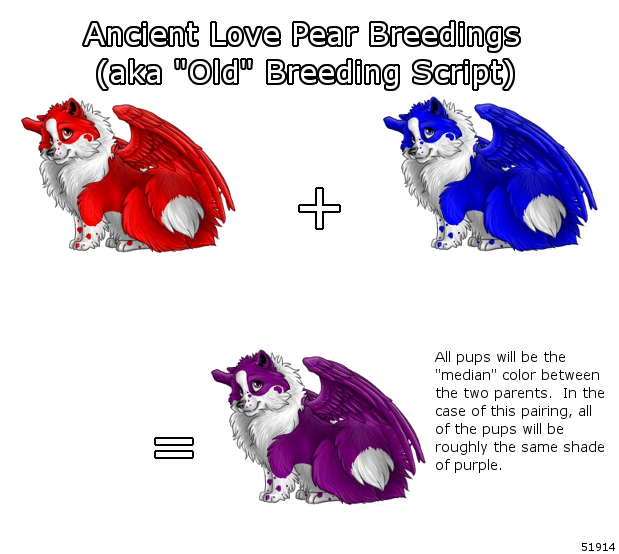
Love Pears - The "New" Script
Using a Love Pear (sometimes called Regular Love Pear) to breed will generate pups using the "new" script. This script was added somewhat recently and creates pups whose colors can be anywhere on the spectrum between the two parents' colors. So a red waja crossed with a blue waja can make a purple pup, or a blue pup, or a red pup, or anywhere in between. The new script makes predicting how your pup will look difficult, but it also results in far more unique looking pups.
It is important to note that the base color, eye color, and the color of each marking and mutation are all determined independently of each other in any breeding. This means that it is generally unwise to use a regular Love Pear when breeding wajas who have markings that need to match each other to look right.
This image further illustrates:
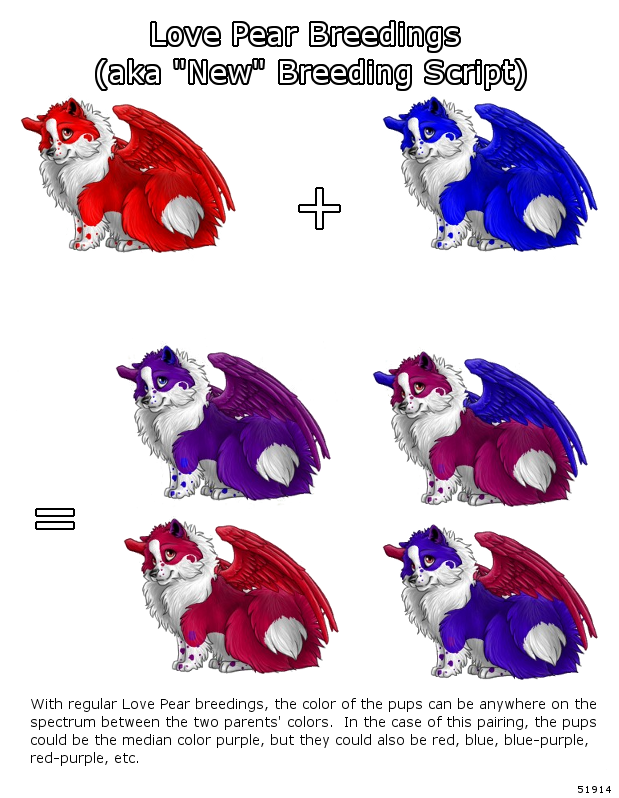
Markings and Mutations
Marking Strength
Marking strength is represented by a number between 1 and 100. This number refers to the opacity at which the marking is set. A 100 mark will be at 100% opacity and fully opaque, whereas a 10 mark will be at 10% opacity and barely visible at all.
A waja with markings that are below 100% strength is referred to as a "Fade" if it is attractive and a "Muddy" if it is unattractive. Some users make projects out of taking a waja with faded markings and trying to breed it with other wajas until they eventually end up with an offspring with 100% markings.
Marking Inheritance
New Breeding Script
June of 2016 Estuko and RocketDave grouped together to tweak the breeding script for marking inheritance. Estuko explained in the news post that it works like so:
"We changed it around so that the opacity levels are a bit easier to work with. Now you're going to get a middle range most of the time with the slight chance of it being really high or really low. The results should never go above/lower what the parents have though.
- If you breed a waja with 100 dalmatian to another that has 100 dalmatian all the puppies should have 100 dalmatian.
- If you breed a waja with 100 dalmatian to a waja that does not have dalmatian the range will be 0-100 but the average will be 30-50s.
- If you breed a waja with 50 dalmatian to one with 40 dalmatian the results should never be higher or lower than the parents. So you're looking at 40-50 opacity.
To increase the opacity of the offspring you would then cross them out with someone who has a higher opacity. If you're trying to breed out a marking you would breed it to one that has a lower opacity or doesn't have it at all."
Color range has not been effected by the new breeding script. Love Pears and Ancient Love Pears still function as normal by either using the median for the colors in the case of the ancient love pear, or using the whole range between the colors with a regular love pear. The following graphic below shows the difference between pups from the old breeding script to the new both examples using Love Pears.
Older Breeding Script
When two wajas are bred together, the markings they share will be passed on to their pup at a strength that is between the strength of the marking in the two parents. Markings that are not shared between the two will be passed on at a low opacity, such as 20 or 30, or more rarely it won't be passed on at all. Marking strength in the pup will never be inherited at a higher opacity than its parents possessed, so there is no way to breed two wajas with a marking at 50 and get a pup whose marking is higher than 50.
The color of the marking will be determined by the color of the marking in the parents and the love pear used. If an Ancient Love Pear was used, the marking will be roughly the median color between the color of the marking in the parents. If a Love Pear was used, the marking could be any color in the spectrum between the two parents' colors. If only one parent had the marking, the pup will have the marking in roughly the same color as the parent that had the marking.
Marking opacity is inherited in increments of 10. So a waja that is born will only be able to have a marking at 10, 20, 30, 40, 50, 60, 70, 80, 90, or 100. Markings that have an opacity that is not an increment of 10 are usually the result of dyes.
The following image should help in understanding how fading of markings works.
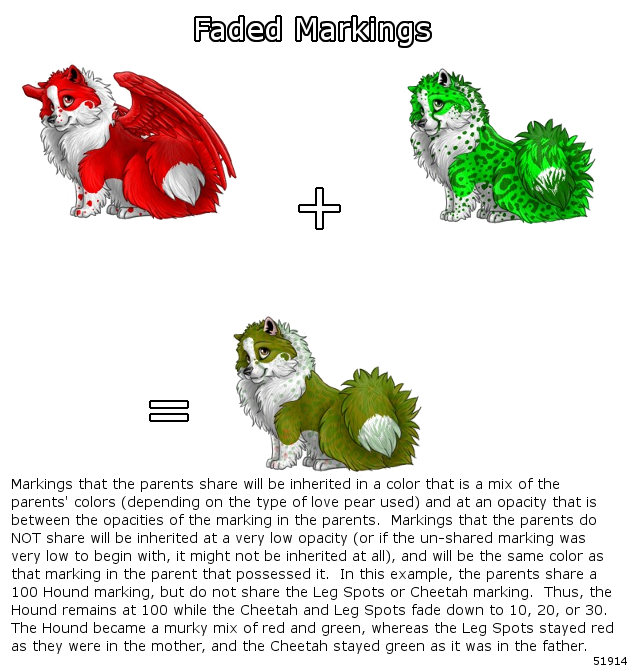
Mutation Inheritance
Mutations are inherited according to this chart (does not factor in MU):
SHOW x SHOW: 100% of pups SHOW the mutation
SHOW x CARRY: 50% of pups SHOW, 50% CARRY
SHOW x NO: 50% CARRY, 50% NO
CARRY x CARRY: 50% CARRY, 25% SHOW, 25% NO
CARRY x NO: 50% CARRY, 50% NO
Show means the waja has the mutation and it is visible. Carry means the mutation is not visible in the waja, but there is still a small chance of the mutation being passed to the waja's pups. No means that waja neither shows nor carries the mutation.
Mutation Gene, or MU percentage also affects how mutations are inherited. The exact formula isn't well understood, and it is frequently debated about whether it actually works in a predictable way at all. It is thought that higher MU results in higher chances of a mutation in the parent showing or carrying in pups. It is also widely believed that you must raise the MU of both parents (even if the other parent doesn't show or carry any mutations) in order to get the best chance of getting pups to show the mutation. Below is an approximate figure of MU as it effects a pair in which one parent has mutations visible and the other has none at all.
Show x None w/0MU = ~15% chance of visible mutation
Show x None w/100MU = ~50% chance of visible mutation
Mutated Markings and Mutations
On higher generation pups (pups born generation 4 or higher), MU increases the likelihood of a mutated Marking or Mutations appearing during breeding though the occurrence is rare. Random Mutations and Markings will not appear on a waja between generation 1 through 3.
Colors
Most colors on wajas behave the same as they would in mixing paint (Red x Blue = Purple, Red x Yellow = Orange, etc.). However, because we are dealing with light rather than pigment, mixing yellow and blue does not make green. Instead, this combination makes gray. For a more in-depth explanation of how hex codes work, please review the below section about color mixing.
Color is a very important part of how a waja looks, so it's not enough to just ensure that you're breeding for strong markings; you need to also pay close attention to how two wajas' colors will blend. A very useful tool in doing this is the Color Mixer found under help on the site. Never assume that just because two wajas are pretty they will make pretty babies. Make sure to take into account not only how the base colors will mix, but also how each individual marking's colors will mix.
As stated above, the color of a marking that is shared will be a mix of the parents' marking colors, whereas the color of markings not shared will be roughly the same color as the marking in the parent that has it.
Mutations work much the same way. A mutation shared between the two wajas (whether in show or carry form) will show up in a color somewhere on the spectrum between the parents' colors. A mutation not shared in any way will show up in roughly the same color as it is in the parent who has it (if it shows up at all; see the mutations section).
Non Vitamin Color Mixing: The Science
This article was originally written by Zita(#63153) [in a sticky] and with permission is being transposed onto the wiki
There are some quirks to the waja color mixing system that aren't immediately obvious when you're new and haven't fooled around with hex codes before. There are 8 colors you can't make by mixing other colors together (primary colors!) and understanding them will help you make good decisions when breeding and picking colors for dyes/customs that you want to be interbreedable. (Because you can't make these by breeding, but you can breed almost anything from the right combination of the basic 8.)
I'm also gonna tell you why blue and yellow don't make green on Wajas.
How Hex Codes Work
The [color mixer] page explains a lot of this, but I'll go over it again to refresh you.
Wajas colors are 6 digit hexadecimal codes (hex codes), which are the standard means of describing colors on a computer monitor. The hex code is 3 pairs of digits, describing (in order) how red, green, and blue the color is.
Therefore, a hex code of #123456 is 12 red, 34 green, and 56 blue.
(The letters come in because it's HEXAdecimal, not your regular old 0-9 decimal system you know and love. The letters A-F represent numbers 10-16. I'm sure you can google that if you want to know more about it, it's neat.)
The smallest any of your color values can be is 00 (black, 0 of that color), and the biggest is FF (FF stands for the number 255). 00 and FF are pure. It's impossible to get a 00 or FF when at least one of your waja's parents doesn't already have it. Your pup's numbers for red, green, and blue on each part of their body/each marking will always be somewhere between the parents'. (And maybe the same as the parents', if you're using a regular Love Pear instead of an Ancient Love Pear.) You can't make colors outside your parent range.
There are 8 possible arrangements of "perfect" 00s and FFs in hex color codes, and these 8 unmixable colors are the Primary Colors of wajadom.
The Eight Colors You Cannot Mix on Wajas
Black and White
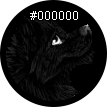
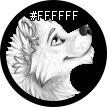
Simple and obvious, right? You can't make #000000 or #FFFFFF, which is why lineages of markless pure white and pure black wajas have always been valuable.
The RGB Primaries
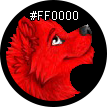
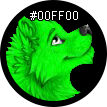
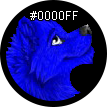
These pure colors are Red, Green, and Blue. They are each pure in one part of their hex code, while the other two parts are black.
The CMY Primaries
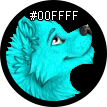
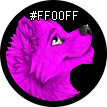
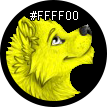
These will be familiar if you've read anything about printing ink colors. (You can google CMYK if you're curious.)
Cyan, Magenta, and Yellow are each pure color in two parts of their hex code, with one part left black.
What Happens When Combining Primaries
(Black and White are pretty obvious, so we'll just talk about the RGBs and CMYs.)
Mixing primaries in the same groups creates colors kind of like the other group.
When you mix any two of Red, Green, and Blue together, you get a dark yellow, a teal, and a purple.

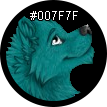
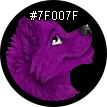
Mixes between the RGB primaries are sort of dark, because each RGB primary has one section at full color and two that are all black in its code.
Like a mirror version of what we just did, mixing Cyan, Magenta, and Yellow produces pastel versions of the RGB primaries.
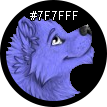
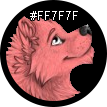
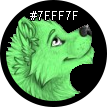
CMY mixes are lighter, because again: they are two parts color and one part black.
Let's Talk About Grey
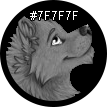
Grey is the easiest color to mix. Anything where your RGB values are sort of close (or like here, the exact same) will be a shade of grey. All muddy wajas lean toward grey in the end. It is like the color singularity, the point to which all bad color decisions eventually lead if you keep breeding poorly matched wajas.
The mostly-similar numbers also mean, however, that grey is the easiest color to color-correct from. (Like say, if you're trying to breed Roosters and something's not quite right. Once you've bred to grey, the non-grey parent's color will have a very strong influence on the pup.)
Why Blue and Yellow Don't Make Green
This is one of the most legendary quirks of the hex color mixing system, it trips up newbie waja breeders all the time. Now that you can see these hex codes, this might make some sense.


The hex for pure blue is #0000FF, it's an RGB primary. The hex for yellow is #FFFF00, it's a CMY primary.
The FF's and 00's in these codes are exact opposites!
That means, just like pure white and pure black, crossing these two colors will create true grey. (You know. With some wiggle room for the breeding script to go one way or the other.)

Oops!
(The same thing will happen if you cross Red and Cyan, or Green and Magenta.)
The Closest You Can Get: An Example
As shown above, mixing your primaries can get you kind of close to each other in a pinch.
Here's a breakdown of how you get a pastel green from other primaries!
You will never get the bright, rich, acid green of #00FF00 without a pure parent, but you can have some success with Yellow and Cyan, not blue. Cyan is a CMY primary, and you can use the red value in yellow to filter the blue out of cyan. Look here.


Check the lineups:
The hex for yellow is #FFFF00
The hex for cyan is #00FFFF
They both have an FF in green. One has nothing in blue, while the other has nothing in red. When bred, the pup will have a middle value in red and blue. Because those two values are the same (or close), they cancel each other out and the green shines through. Your result is going to be somewhat greyed because you have something besides 00 in your red and blue, but it works!

(The same holds true if you want to breed a red from Yellow/Magenta or a blue from Cyan/Magenta.)
You'll get better results if the colors you're mixing are closer to the one you want. Knowing this, you can select mates to manipulate colors without having to check the color mixer so much.
If you want to breed a primary color waja, it's best to find wajas that are already pure in that color (or close enough, if you don't need pure). But if you just want to get something sorta close (maybe so you can breed it with a more ideal mate), you now know enough to help yourself do so! :D
RAINBOW and CHROME Hexes: A special case
If a waja with a marking with "RAINBOW" in the hex code field is bred to another waja with the marking in a regular hex color, the pups will always inherit the marking in rainbow if an Ancient Love Pear was used. However, if a regular Love Pear was used, there is a very small chance that the pup might inherit the exact hex of the non-rainbow parent.
Breeding Stats
There are four breeding stats:
Litter Quantity
Main article: Litter Quantity
LQ = Litter Quantity. This stat determines how many pups the waja will have per litter.
| 0-19 LQ | 20-59 LQ | 60-89 LQ | 90-100 LQ | |
|---|---|---|---|---|
| 4 pups | 0% chance | 0% chance | 2% chance | 5% chance |
| 3 pups | 0% chance | 5% chance | 40% chance | 68% chance |
| 2 pups | 20% chance | 60% chance | 53% chance | 27% chance |
| 1 pup | 80% chance | 35% chance | 5% chance | 0% chance |
LQ can be viewed on the waja's page. You can raise a waja's LQ by feeding it Normal Pears.
Mutation Gene
Main article: Mutation Gene
MU = Mutation Gene. Mutation Gene, more commonly known as MU, is a stat that determines the likelihood of the waja's pups inheriting the mutations of the parents. On higher generation pups (pups born generation 4 or higher), this stat increases the likelihood of a mutated Marking or Mutation appearing though the occurrence is rare.
MU can be viewed on the waja's page. You can raise a waja's MU by feeding it Strange Pears.
Male Gene
Main article: Male Gene
MG = Male Gene. This stat determines what percentage of the waja's offspring will be born male. The higher the MG, the higher the likelihood of male pups, to a maximum value of 100. For example, if both parents have 100 MG then all offspring will be born male, and if they both have 0 MG then all offspring will be born female.
MG can be viewed on the waja's page. You can raise a waja's MG by feeding it Male Pears.
Inbred Percentage
Main article: Inbred Percentage
IN% = Inbred percent. This is how inbred your waja is. As inbreeding is generally frowned upon for its real world implications and for being seen as lazy, wajas that are inbred are usually considered to be worth less than non-inbred wajas; so if your waja is inbred, there is less likelihood of it being bought. If they are bought, there is a chance of them just being given to the OWF.
IN% can be viewed on the waja's page. You can reduce a waja's IN % by feeding it Ice Pears.
Pup Predicting
Pup predicting can help you to know what kind of pup you're going to get before you breed, saving you time and money that could be wasted on a bad pairing. While it's difficult to predict how Love Pear breedings will turn out due to the large number of possibilities, it's fairly simple to predict roughly how an Ancient Love Pear breeding will come out.
- In one tab, open the Custom Demo (found under world).
- In another tab, open the Color Mixer (found under help).
- In two more tabs, open the pages of both parents.
- On the custom demo page, start putting in the markings of the mother (do not edit the color or strength of the markings yet), going from top to bottom.
- Once you've put in all the markings the mother has in the order she has them, you can now add any markings that the father does not share with the mother.
- Now we can start filling in opacities. For any marking that they share, pick roughly the average of their opacities and enter it (keeping in mind that markings are inherited in increments of 10). So if the mother had a marking at 100 and the father had the marking at 50, we're going to guess about 70.
- For any marking they don't share, set the opacity at 10 or 20. Remember that a marking cannot be inherited by a pup at a higher opacity than the parents had. So if one parent has a marking at 10 and the other parent doesn't have it at all, you can guess that marking's opacity as being 10, but not 20.
- Now, for base color, eye color, misc color, and each marking they share, enter their colors into the Color Mixer. Copy and paste the median color's code into the corresponding slot in the Custom Demo.
- If they both share a mutation, or if they both carry the mutation and you'd like to see how it might look if it shows up in the pups, do the same for the mutation.
- If one waja shows/carries a mutation but the other does not, then if it shows up it will show up in the color of the parent who has it, just like unshared markings do. However, it is unlikely it will show up unless the wajas have a high MU
- For each marking they don't share, copy and paste that marking's color from the parent who has the marking into the corresponding slot in the custom demo.
- Press "Preview".
Breeding for Profit
If you plan to breed wajas in order to sell them for a profit, there are some things for you to keep in mind.
- Lower generation wajas are generally worth more than higher generation wajas, with generation 2 and 3 being the most valuable bred wajas.
- Likewise, wajas with stronger markings tend to sell for more than wajas with weaker markings. Wajas with all 100 markings are generally considered worth much more than wajas with faded markings.
- Pay close attention to colors and how they blend when breeding to ensure you get nice looking pups.
- Remember to take into account possible mutations. If both wajas carry Bat Wings, there's a decent chance of the pups having them too (depending on the parents' MU). This can be a good or a bad thing, depending on the pair.
- Do not inbreed. Inbred wajas are worth drastically less than non-inbred wajas, and many users won't buy inbred wajas at all.
- Use dyes sparingly and tastefully. Generally, cheap shop dyes like Kitsune, Giraffe, Jester, and Heart Cape are so over-used that they will usually bring down the value of a waja (unless used creatively), whereas expensive dyes like Dalmatian and Collar will increase it.
- Likewise, use potion mutations sparingly. It is generally best to avoid adding these mutations to your waja, as many users are picky about them and the potions are cheap enough that your average user can afford to add them for themselves if they want them.
- Avoid over-done marking combos, such as cheetah/belly, husky/ocelot, husky/wind, etc. Most users will already own a waja like this and won't be interested in buying more like it.
- Start a sales thread on the Waja Sales board on the forums. Post pictures and links to the wajas you're trying to sell. If you don't know how to post links or pictures, check out the HTML page to learn how.
- The Pricing Wajas page has good tips on how to price the wajas you plan to sell.
Releasing
During your adventures in the world of breeding wajas, you're likely to make some mistakes. If you breed a waja that is unattractive and you do not want it for yourself, or if you bred two wajas by accident and they turned out inbred, it's best to release the resulting offspring to live with the Obsessed Waja Fan rather than trying to sell them. This frees up valuable space in the server for new, wanted wajas to be created and keeps the waja search clean.
Common Terms Used in Breeding
- LQ: Litter Quantity. Can be increased by using Normal Pears. Litter Quantity increases the chance of how many pups are born in one litter (up to 4 per litter).
- MG: Male Gene. Can be increased with Male Pears. MG increases the chance of males being born in the litter.
- MU: Mutation Gene. This can be increased by using Strange Pears. It increases the chances of mutations being passed down to pups.
- In%: Inbred Percentage. Shows how inbred a waja is. The site only counts inbreeding if it occured within the last two generations. Can be reduced using Ice Pears (though the waja is still inbred, as you can't change its lineage).
- IBP: Instant Birth Pear. When fed to a pregnant waja, she will instantly give birth. Very expensive item.
- LP: Love Pear. Used to breed Wajas. Owner of the female supplies this.
- ALP: Ancient Love Pear. Used to breed Wajas with the old breeding script. Owner of the female supplies this.
- Studs / Studding: This is the term used for male wajas that are available for breeding, usually for a fee.
- Reverse Breeding: Also known as RB. This term refers to a female waja that is available for breeding, usually for a fee. These are usually more expensive than studs as the waja will be out of commission for 5 days while carrying your pups.
- Breed Dominance: When breeding two wajas of different breeds, breed dominance determines how likely you are to get one breed or the other in the pups.
